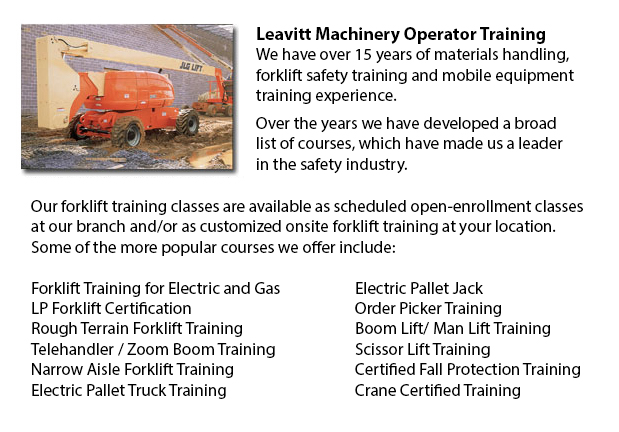
Kingston Boom Lift License - To operate an aerial boom lift, operators should be qualified through training which can be obtained using both practical training and classroom sessions and by obtaining a boom lift license. Instruction should be given with respect to the kind of aerial lift which will be used on the job. A License is required for any individual who operates or works on an aerial boom lift.
Various types of vehicle-mounted aerial devices consist of extensible boom platforms, aerial ladders, articulating boom platforms, vertical towers, and whatever combination of these types.
When making use of a boom lift, there are several basic safety rules that apply to all boom lifts. Safety of the worker is a main concern while they are working inside the basket. The worker must always wear a body harness and lanyard, connecting it to the boom or basket. Never tie off to an equipment, an adjacent pole or a structure. Staff must stand on the floor of the basket, and never climb or sit on the edge of the basket. The load limitations of the manufacturer should be followed.
Aerial lift operators should be authorized to utilize the machines. The operator needs to be familiar with all the aspects of the device and should have access to the manufacturers instruction manual which should be kept inside the lift. Operators are responsible for ensuring that safety procedures are followed in operating the lift. A daily test of lift controls must be done. Set brakes and position outriggers (if they are used) on a stable surface or on pads. If working on a slope, use wheel chocks.
Never move an aerial lift truck with an elevated boom whilst employees are within the basket. Articulating boom and extensible boom platforms utilized as personnel carriers must have accessible, plainly marked, upper controls. Except in emergency cases, lower controls should not be utilized to override upper controls unless the individual within the lift gives consent.
While working from an aerial lift, do not wear pole or tree climbers.
Do not alter the insulated part of the aerial lift.
Do inspect the booms to make sure that it is correctly cradled and the outriggers are in the stowed position before moving.
Make sure that lifts being utilized in or near power lines are di-electrically tested and conform to local rules.
-
Narrow Aisle Forklift / Order Picker Training / Electric Pallet Jack / Electric Pallet Truck Training in Kingston
A pallet lift is a piece of equipment dedicated in the moving of pallets of various dimensions and weights. They might be utilized as an accessory for forklifts, cranes and other styles of heavy machinery or be applied on their own. Pallet lifts are... More -
Kingston Forklift Training School
Kingston Forklift Training School - Forklift Training School - Industry and federal regulators have established the criteria for forklift safety training based on their existing regulations and standards. People wishing to operate a forklift must fin... More -
Kingston Scissor Lift Certification
Kingston Scissor Lift Certification - Scissor lift platforms are utilized at work locations to enable tradespeople - such as iron workers, welders and masons - to reach their work. Making use of a scissor lift platform is usually secondary to their t... More -
Kingston Boom Lift Safety Training
Kingston Boom Lift Safey Training - Boom lifts are a type of elevated work platform or aerial lifting device that are normally utilized in warehousing, construction and industry. Boom lifts could be made use of in practically whichever environment du... More -
Kingston Fall Protection Ticket
Kingston Fall Protection Ticket - Fall-related incidents are the number one reason of death in the construction business. The possibility for fall accidents very much increases based upon the type of work which is being accomplished within your workp... More -
Telehandler Training in Kingston
Telescopic handlers normally called telehandlers for short, are an extremely popular piece of heavy construction machinery. They are widely utilized in the construction and agricultural trades. These machines have farthest reaching ability and are ab... More -
Kingston Warehouse Forklift Training Programs
Kingston Warehouse Forklift Training Programs - Warehouses could either be retail, industrial or commercial facilities, functioning from bulk product retailing to product distribution services. Regardless of the type of warehouse, personnel inside wa... More -
Kingston Heavy Equipment Ticket
Kingston Heavy Equipment Ticket - Depending on the nature of the job at hand, the kind of construction machinery that a heavy equipment operator utilizes varies. Every type of equipment is built to do particular jobs in the most effective method comm... More

Forklift Certification Kingston
TOLL FREE: 1-888-254-6157
Kingston, Ontario
forkliftcertificationkingston.com
Email Us
About Us


